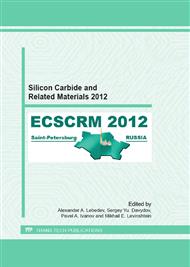p.990
p.994
p.998
p.1002
p.1006
p.1010
p.1014
p.1018
p.1024
Bipolar Conduction across a Wafer Bonded p-n Si/SiC Heterojunction
Abstract:
This paper describes the physical and electrical properties of a p-n Si/on-axis SiC vertical heterojunction rectifier. A thin 400nm p-type silicon layer was wafer-bonded to a commercial on-axis SiC substrate by room temperature hydrophilic wafer bonding. Transmission electron microscopy was used to identify the crystallographic orientation as (0001)SiC//(001)Si and to reveal an amorphous interfacial layer. Electrical tests performed on the p-n heterodiodes revealed that, after an additional 1000oC anneal, the rectifier exhibit remarkably low leakage current (10nA/cm2 at an anode voltage of V=-6V), improved on-resistance due to bipolar injection and a turn-on voltage close to the p-n heterojunction theoretical value of 2.4V.
Info:
Periodical:
Pages:
1006-1009
Citation:
Online since:
January 2013
Keywords:
Price:
Сopyright:
© 2013 Trans Tech Publications Ltd. All Rights Reserved
Share:
Citation:


